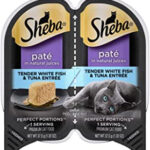Considering adding a feline friend with a little extra fluff and size to your family? You might be drawn to the charm of big cats, domestic breeds that can tip the scales at 20 pounds or more—significantly larger than your average house cat. While their impressive stature offers more cat to love, it’s crucial to understand that these breeds come with unique needs. Just like you’d invest in sturdy cat trees and pay attention to food portion sizes, choosing a big cat breed means preparing for a pet that requires thoughtful care to thrive. Maintaining a healthy weight is especially important for these larger felines.
Let’s explore 10 remarkable big domestic cat breeds that are sure to capture your heart.
Key Insights into Big Cat Breeds
- While the typical domestic cat weighs between 8 and 12 pounds, big cat breeds can healthily reach 20 pounds and beyond.
- Accommodating large house cat breeds requires larger and more robust pet furniture, including cat trees, scratching posts, and litter boxes.
- Preventing obesity is paramount for big cat breeds as excess weight can lead to various health complications, even in these larger framed animals.
1. Maine Coon
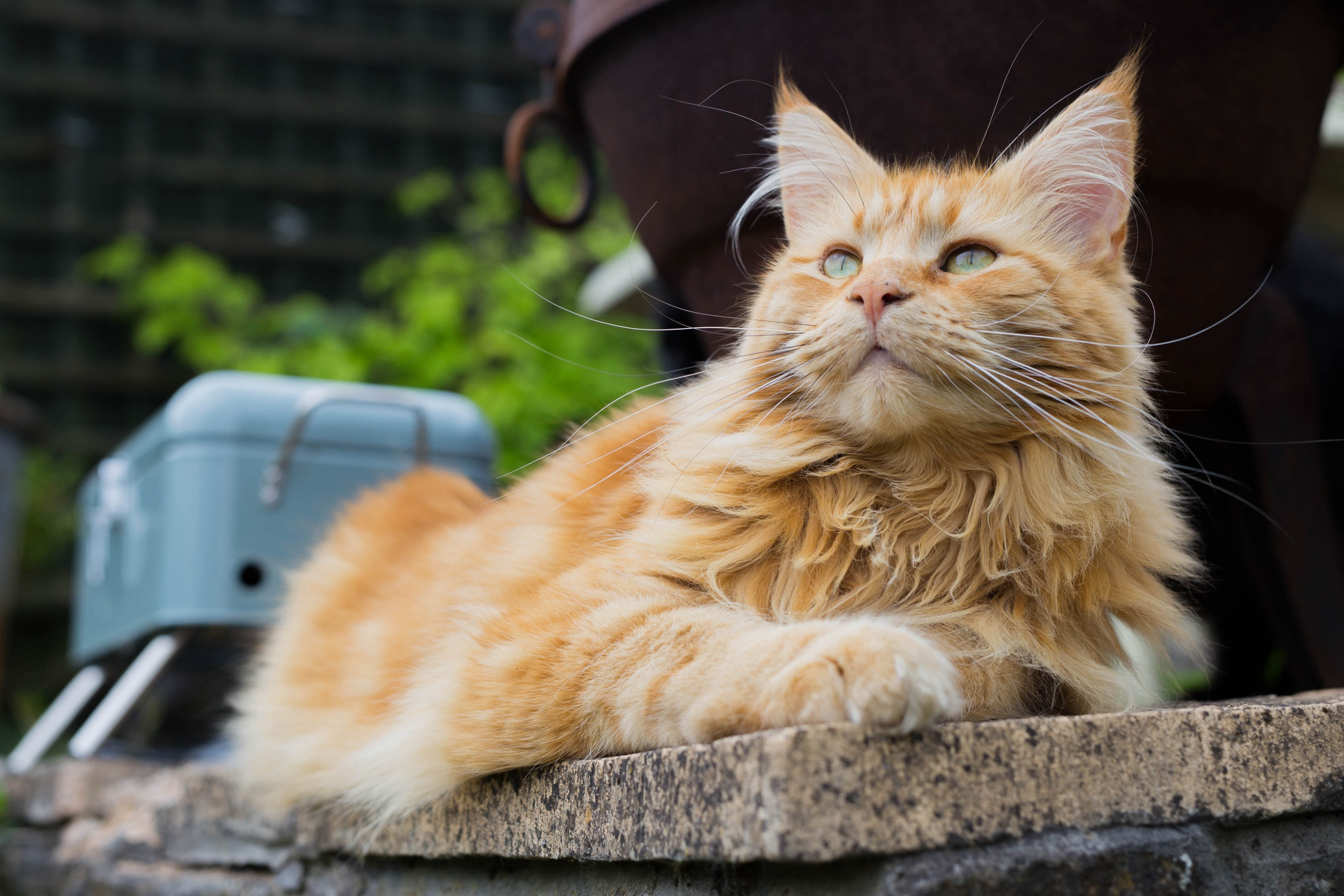 A majestic orange Maine Coon, one of the largest cat breeds, relaxing on the floor
A majestic orange Maine Coon, one of the largest cat breeds, relaxing on the floor
Photo by Adobe Stock/Crashin/Wirestock
Weight: 8–18 pounds
The Maine Coon stands out as one of the most beloved big domestic cat breeds, celebrated for both its impressive size and wonderfully friendly nature. Renowned for their loyal and laid-back personalities, these gentle giants are often considered excellent family pets. Maine Coons adapt well to homes with children and other animals, making them a versatile choice for many households.
However, their larger size necessitates some adjustments in your home. Maine Coons need spacious litter boxes to comfortably do their business, and heavy-duty scratching posts to accommodate their robust scratching habits. It’s also important to be aware that Maine Coons have a predisposition to hip dysplasia. Regular veterinary checkups are crucial for monitoring their joint health and ensuring they remain comfortable and mobile throughout their lives.
Consult with your veterinarian about proactive measures you can take to support your Maine Coon’s joint health. They may recommend joint supplements to help maintain healthy joint function as your feline companion ages.
2. Norwegian Forest Cat
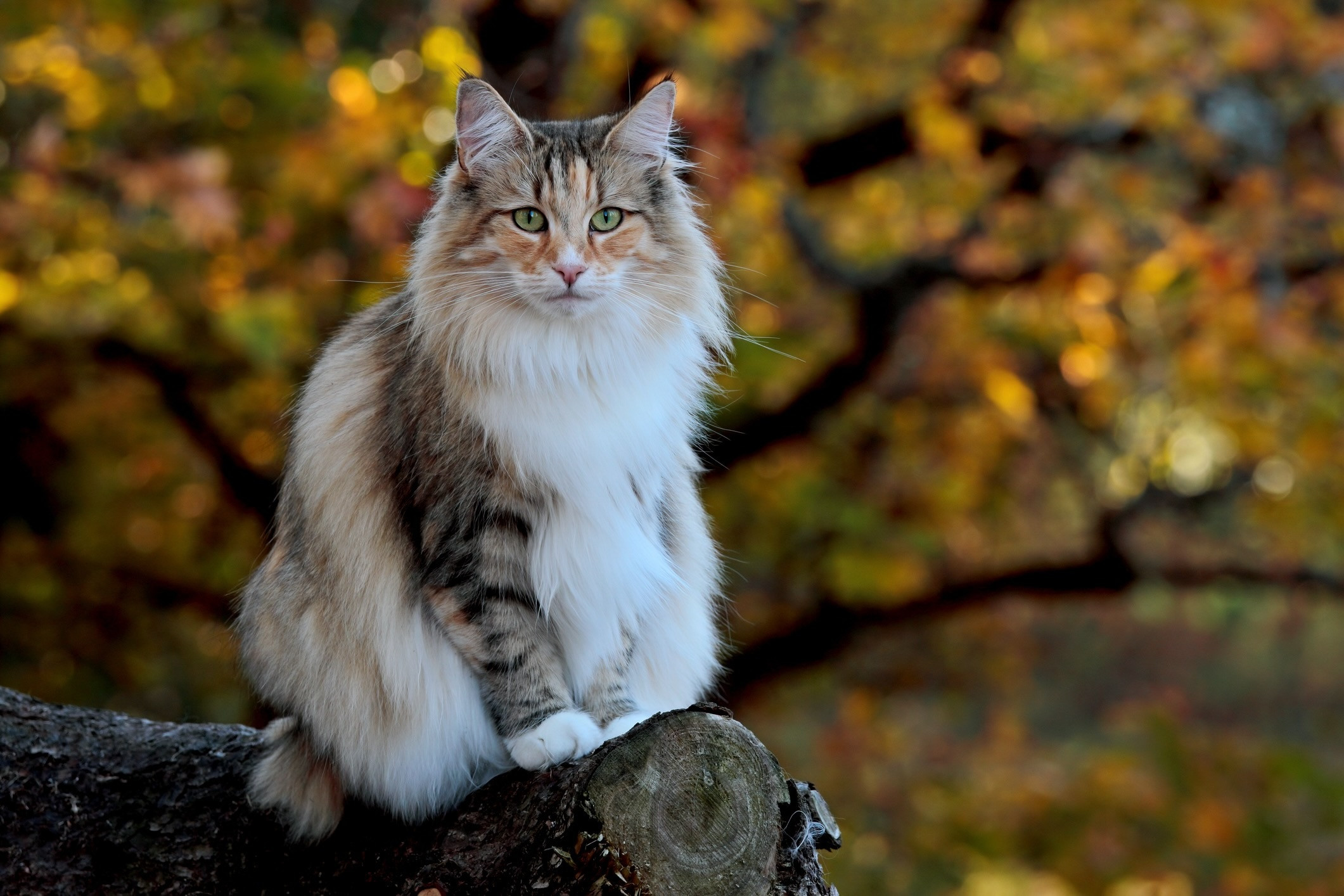 A beautiful calico Norwegian Forest Cat, a large breed, perched gracefully on a log outdoors
A beautiful calico Norwegian Forest Cat, a large breed, perched gracefully on a log outdoors
Photo by undefined undefined/iStock / Getty Images Plus via Getty Images
Weight: 12–16 pounds
Don’t be deceived by their luxurious, thick fur – the Norwegian Forest Cat, affectionately nicknamed “Wegie,” is genuinely as large as they appear. Originating from the forests of Norway, these cats are natural climbers with a love for heights. To cater to their arboreal instincts, Norwegian Forest Cats thrive when provided with sturdy and tall cat trees and perches that can support their weight and encourage their active lifestyle.
While Wegies are generally robust and healthy cats, their size does make them prone to certain joint issues like hip dysplasia and arthritis. Therefore, maintaining a healthy weight is particularly crucial for this large, fluffy cat breed. A balanced diet and regular exercise will help keep your Norwegian Forest Cat in top condition and prevent unnecessary strain on their joints.
3. Siberian
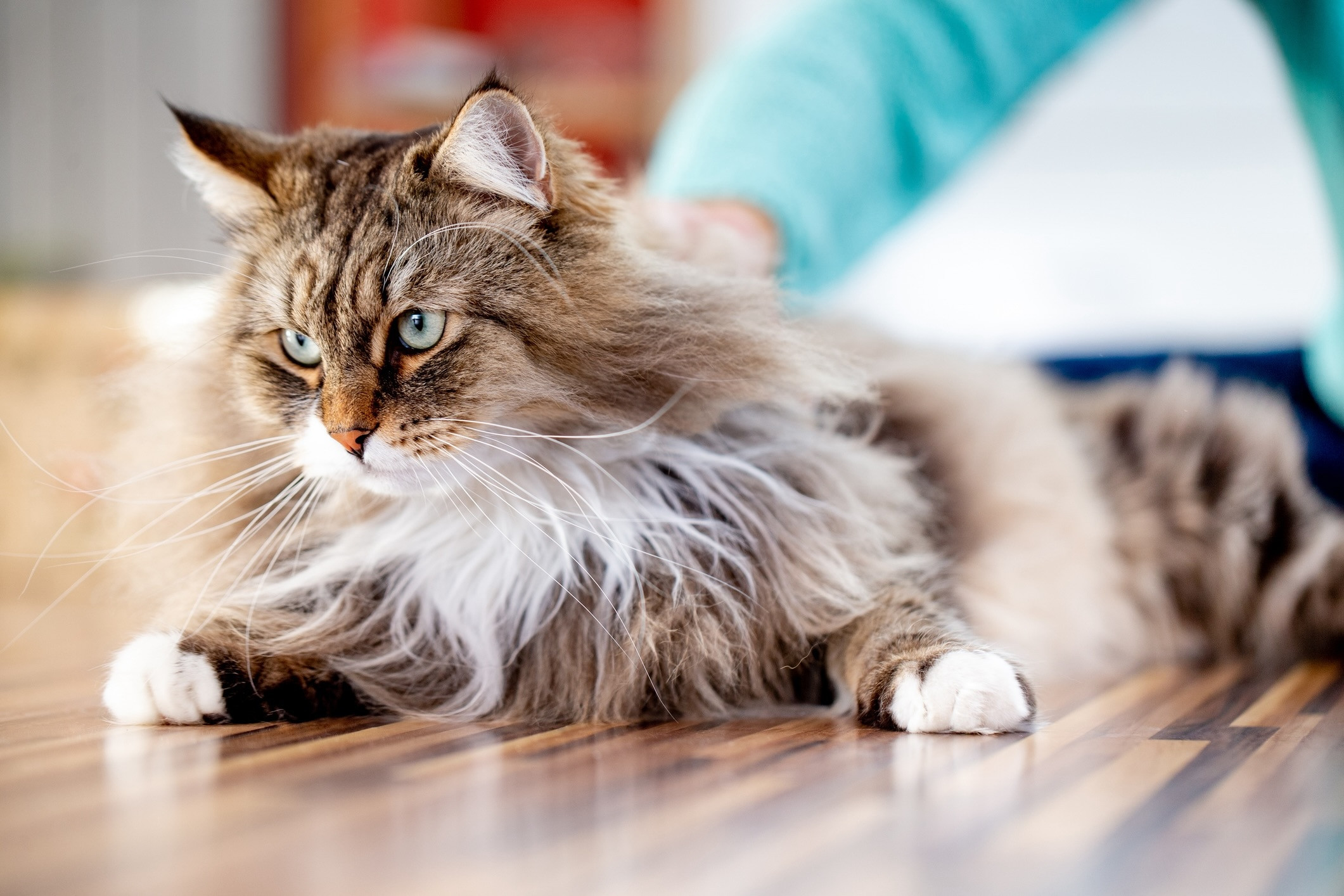 A Siberian cat, a large and fluffy breed, being lovingly petted while lying on the floor
A Siberian cat, a large and fluffy breed, being lovingly petted while lying on the floor
Photo by CasarsaGuru/E+ via Getty Images
Weight: 12–15 pounds
The Siberian, Russia’s national cat, is a breed that exudes elegance and charm. Distinguished by their magnificent triple coat, which provides excellent insulation against harsh climates, and their captivating, expressive eyes, Siberians are truly striking big cats. Interestingly, this breed is known for its slow maturation, often taking up to five years to reach their full physical size.
Despite their somewhat cuddly and relaxed demeanor, Siberians can be prone to obesity if their diet and activity levels are not carefully managed. While they might prefer lounging indoors to energetic chases, it’s essential to encourage daily playtime to keep them physically and mentally stimulated. These intelligent kitties can even be leash trained, opening up opportunities for safe outdoor adventures. Regularly monitoring their weight will help ensure your Siberian stays healthy and trim.
4. Bengal
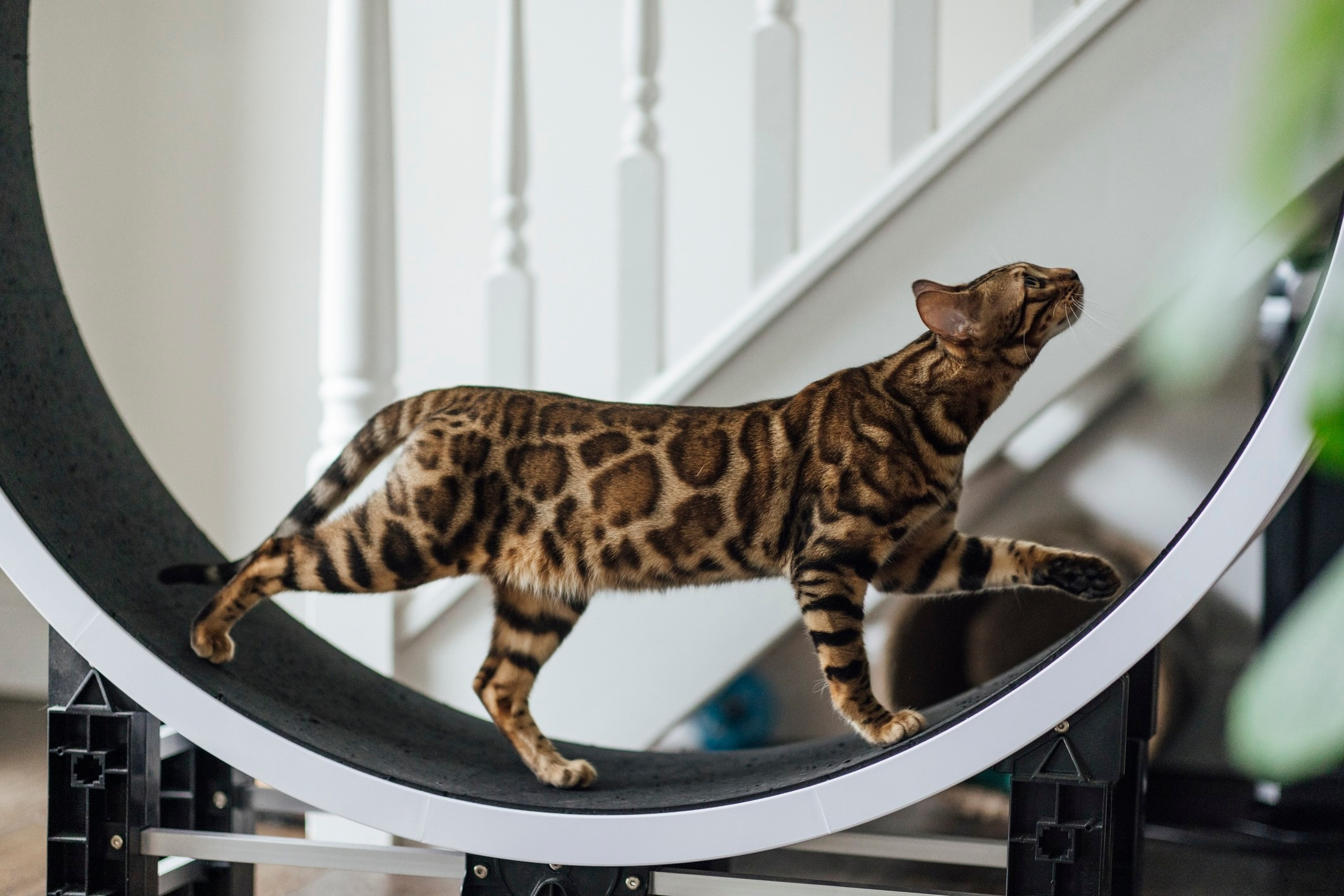 A Bengal cat, a big and athletic breed, confidently walking on a cat exercise wheel
A Bengal cat, a big and athletic breed, confidently walking on a cat exercise wheel
Photo by SolStock/E+ via Getty Images
Weight: 8–15 pounds
The Bengal cat is a breed that embodies exotic beauty and remarkable athleticism, often likened to a miniature leopard due to their distinctive spotted or marbled coats. While Bengals enjoy their downtime and can nap as much as any other cat, they are inherently energetic and require ample vertical space to satisfy their love for jumping and climbing.
Bengals possess a strong hunting instinct, which can be playfully channeled through interactive feeding methods. Puzzle feeders and treat-dispensing toys are excellent tools to engage their predatory drives and provide mental enrichment. These toys not only make mealtime more stimulating but also help prevent boredom and destructive behaviors. Providing a Bengal with outlets for their energy is key to a happy and harmonious home.
5. Savannah
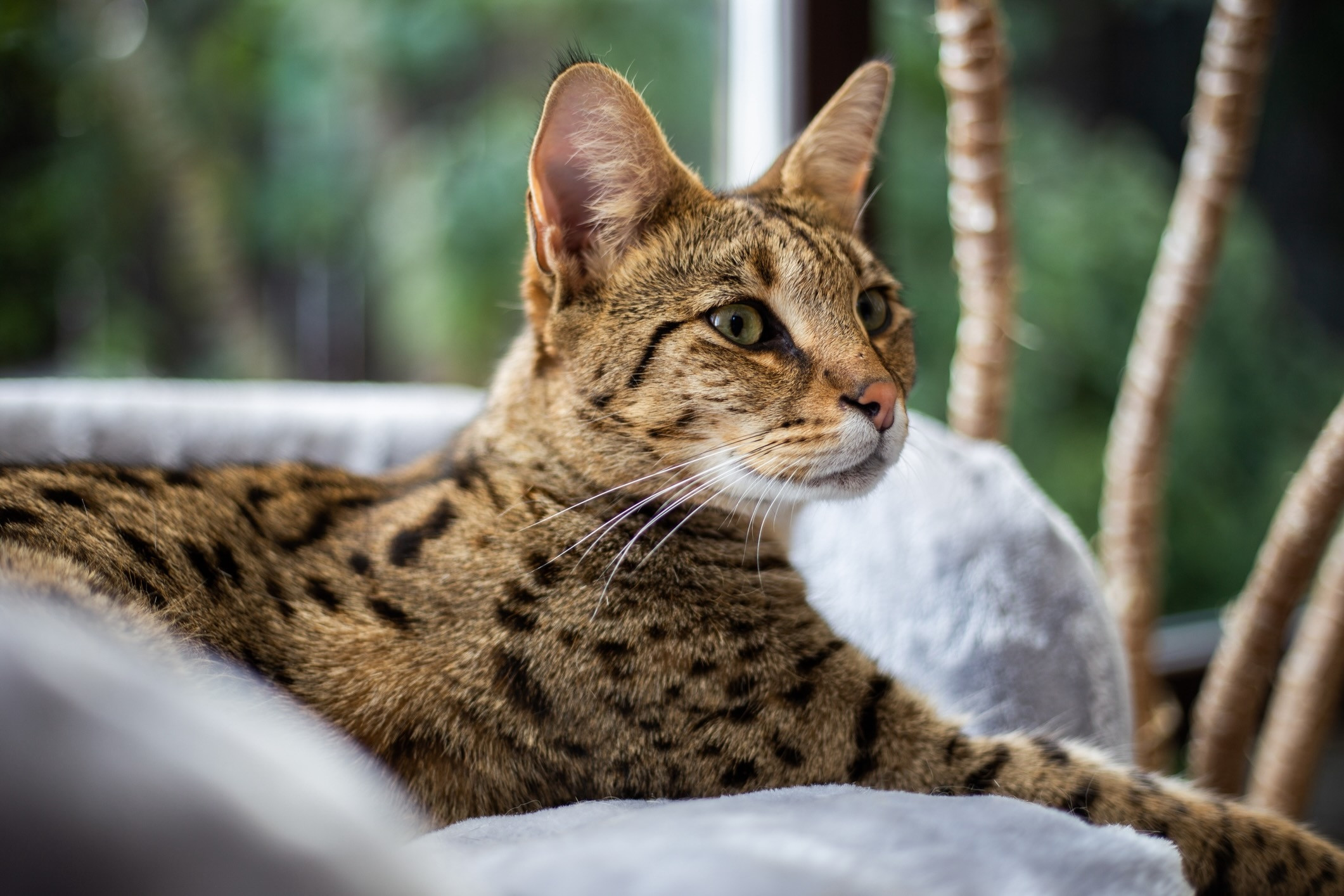 A Savannah cat, a tall and slender big breed, elegantly lounging on a chair indoors
A Savannah cat, a tall and slender big breed, elegantly lounging on a chair indoors
Photo by Gennadiy Naumov/iStock / Getty Images Plus via Getty Images
Weight: 12–25 pounds
The Savannah cat possesses a wild and captivating appearance, making them look as though they would be equally comfortable roaming the African Serengeti as they are in your living room. This breed is a fascinating hybrid, resulting from a cross between an African Serval and a domestic house cat. Despite their exotic lineage, Savannahs are known for their sweet and affectionate temperaments and boundless energy. One of their most impressive traits is their remarkable jumping ability – they can leap up to 8 feet in the air!
To accommodate their athleticism, Savannahs need environments that cater to their climbing and jumping inclinations. Durable and tall cat trees and securely mounted shelves are essential additions to a Savannah cat household. These features allow them to safely explore their vertical world and expend their considerable energy in a positive way.
6. Ragdoll
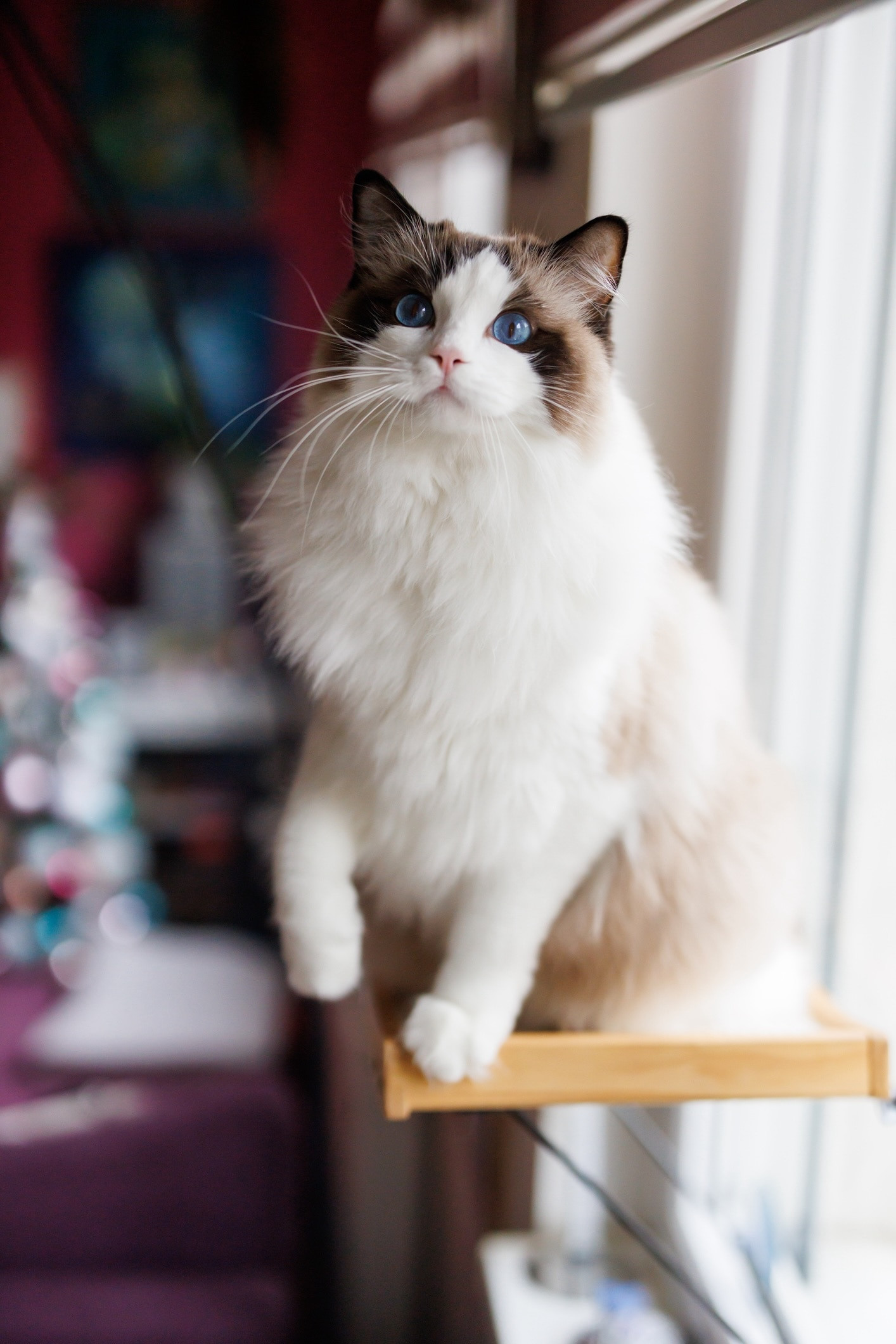 A beautiful Ragdoll cat, a large and docile breed, perched atop a cat tower, observing its surroundings
A beautiful Ragdoll cat, a large and docile breed, perched atop a cat tower, observing its surroundings
Photo by bojanstory/E+ via Getty Images
Weight: 10–20 pounds
Ragdolls are aptly named for their tendency to go limp and relaxed when held, showcasing their incredibly sweet and docile nature. As gentle giants, Ragdolls make exceptional companions, known for their affectionate and people-oriented personalities. While they are considered a big cat breed, they grow at a slower pace and typically don’t reach their full size and weight until around 4 years of age. However, their laid-back and relaxed disposition can make them prone to weight gain if their diet and exercise are not monitored.
To maintain a healthy weight and prevent obesity and arthritis, portion control and regular playtime are crucial for Ragdolls. Even though they might be naturally inclined to relax, they can be easily enticed to exercise with engaging games of fetch and interactive clicker training. These activities provide both physical and mental stimulation, keeping your Ragdoll happy and healthy.
7. RagaMuffin
 A dilute calico RagaMuffin, a large and fluffy cat breed, leisurely lounging on a patio under protective netting
A dilute calico RagaMuffin, a large and fluffy cat breed, leisurely lounging on a patio under protective netting
Photo by rachasuk/Creatas Video via Getty Images
Weight: 10–20 pounds
Similar to the Ragdoll, the RagaMuffin is a slow-maturing breed that doesn’t reach its full grown size until around 4 years old. This fluffy cat breed is naturally big-boned and substantial, meaning you’ll need to invest in larger cat supplies to comfortably accommodate them throughout their lives.
Think jumbo-sized cat trees that can support their weight, spacious litter boxes for their comfort, and appropriately sized carriers for safe transportation. As RagaMuffins age, they can be susceptible to developing arthritis, making proactive joint health care essential. Providing proper nutrition and ensuring regular, gentle exercise from a young age can significantly contribute to their long-term joint health and overall well-being.
8. American Bobtail
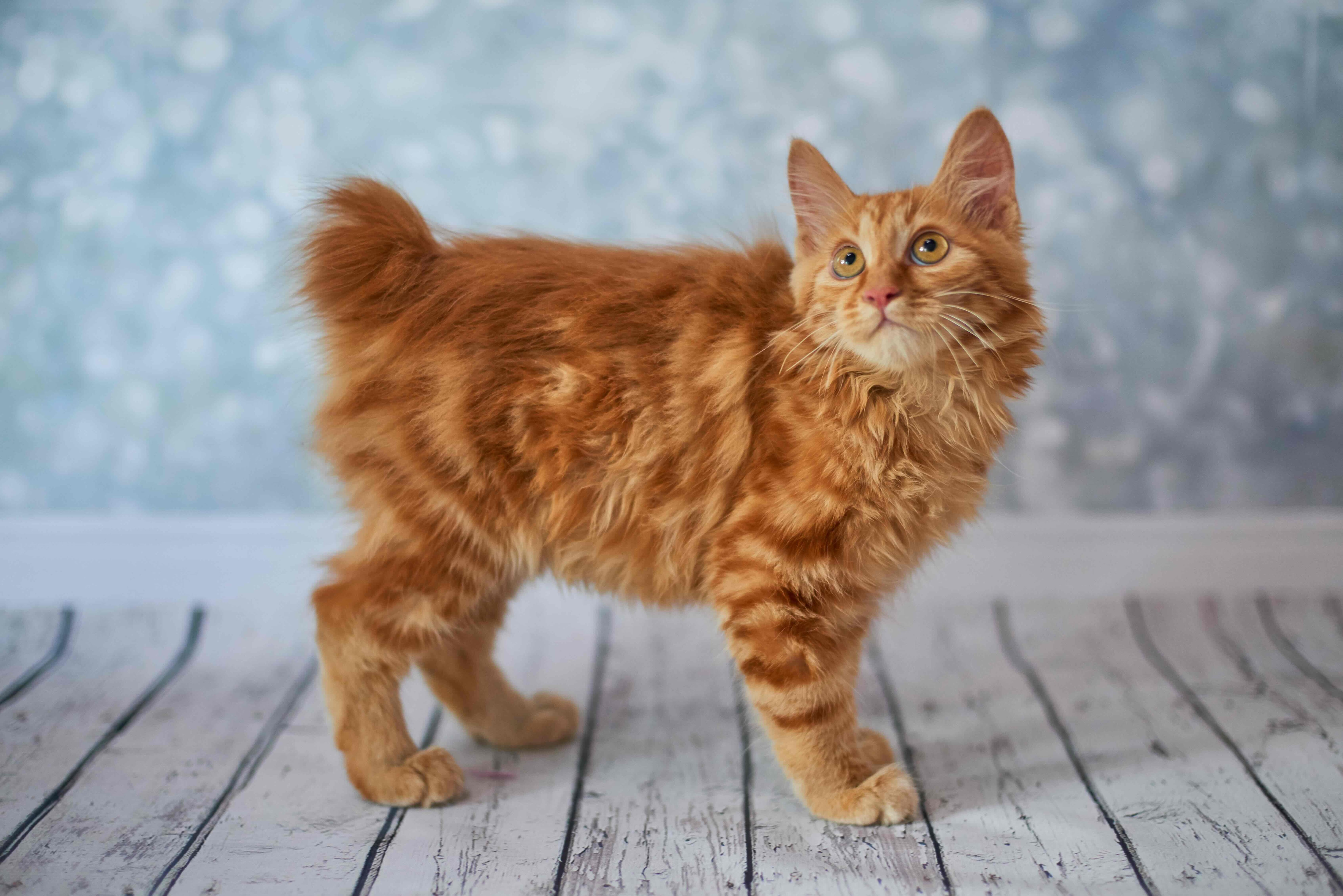 An adorable orange American Bobtail kitten, a smaller big cat breed, standing and curiously looking upwards
An adorable orange American Bobtail kitten, a smaller big cat breed, standing and curiously looking upwards
Photo by Adobe Stock/jane_khomi
Weight: 7–16 pounds
Named for their distinctive short, or “bobbed,” tail, the American Bobtail is a breed known for being both affectionate and surprisingly active. Despite their bobbed tail, which is a naturally occurring genetic mutation, they are agile and playful cats. This intelligent breed excels at puzzle feeders, demonstrating their problem-solving abilities, and many can even be trained to walk comfortably on a leash, opening up opportunities for outdoor exploration.
It’s worth noting that the genetic mutation responsible for their bobbed tail can also predispose American Bobtails to certain spine and hip issues. To support their overall health and minimize potential joint problems, feeding an AAFCO-compliant diet is highly recommended. This ensures they receive all the necessary nutrients to maintain an ideal weight and support healthy skeletal development.
9. British Shorthair
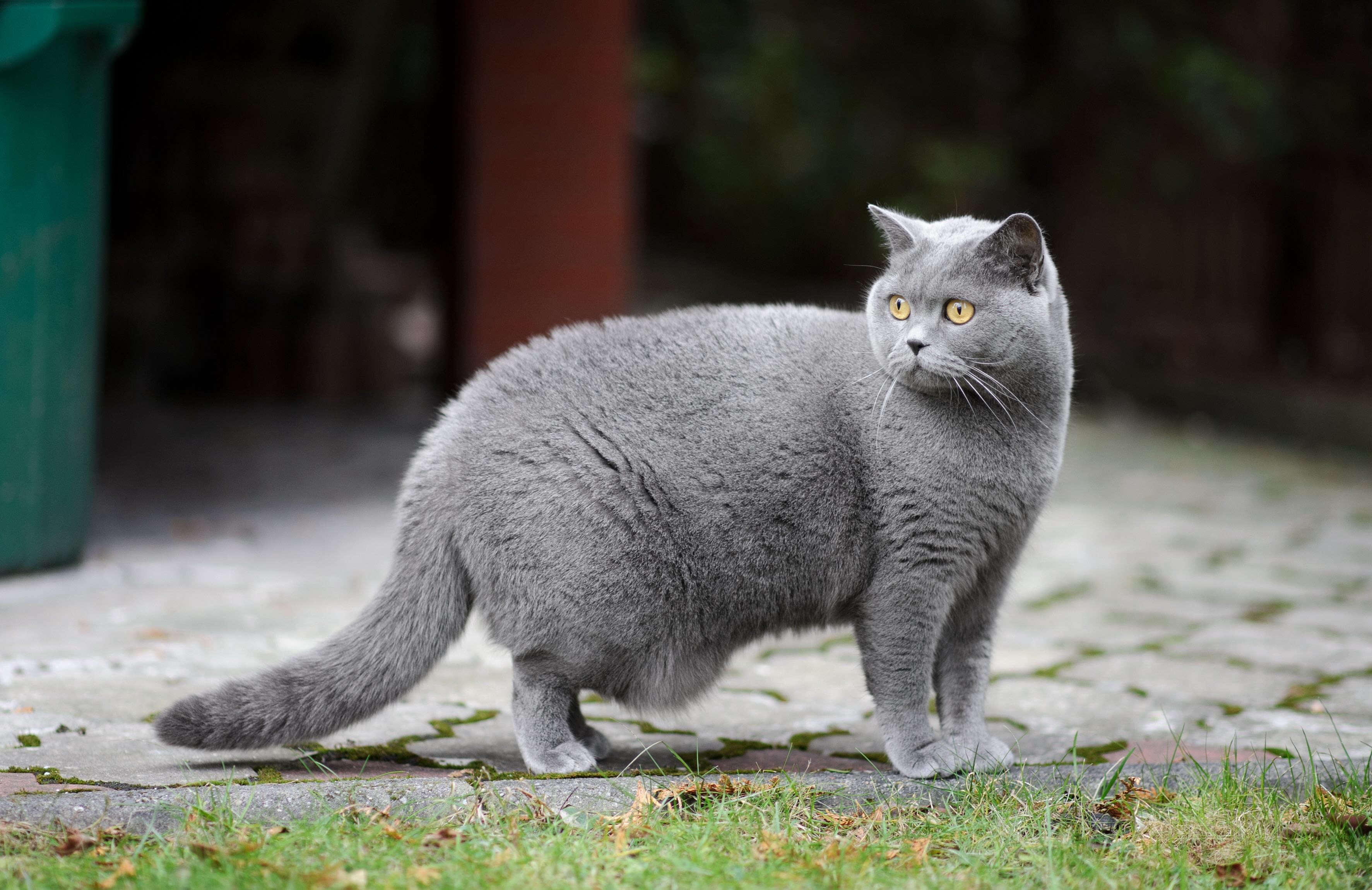 A blue British Shorthair, a sturdy big cat breed, standing alertly outdoors in a garden setting
A blue British Shorthair, a sturdy big cat breed, standing alertly outdoors in a garden setting
Photo by Adobe Stock/gilotyna
Weight: 7–17 pounds
The British Shorthair enjoys a well-deserved reputation for being a calm, adaptable, and remarkably easygoing cat breed. Their relaxed and undemanding nature makes them wonderful companions for a variety of households. However, British Shorthairs are naturally inclined to be less active and prefer lounging to leaping and running. This tendency towards a sedentary lifestyle means they require encouragement to stay physically active and maintain a healthy weight.
Interactive toys, such as feather wands that mimic prey, and enticing catnip toys can effectively motivate them to move and play. Portion control at mealtimes, along with minimizing treats, is also essential to prevent unwanted weight gain, which could put undue stress on their joints over time. A balanced approach to diet and play will keep your British Shorthair happy and healthy.
10. Turkish Van
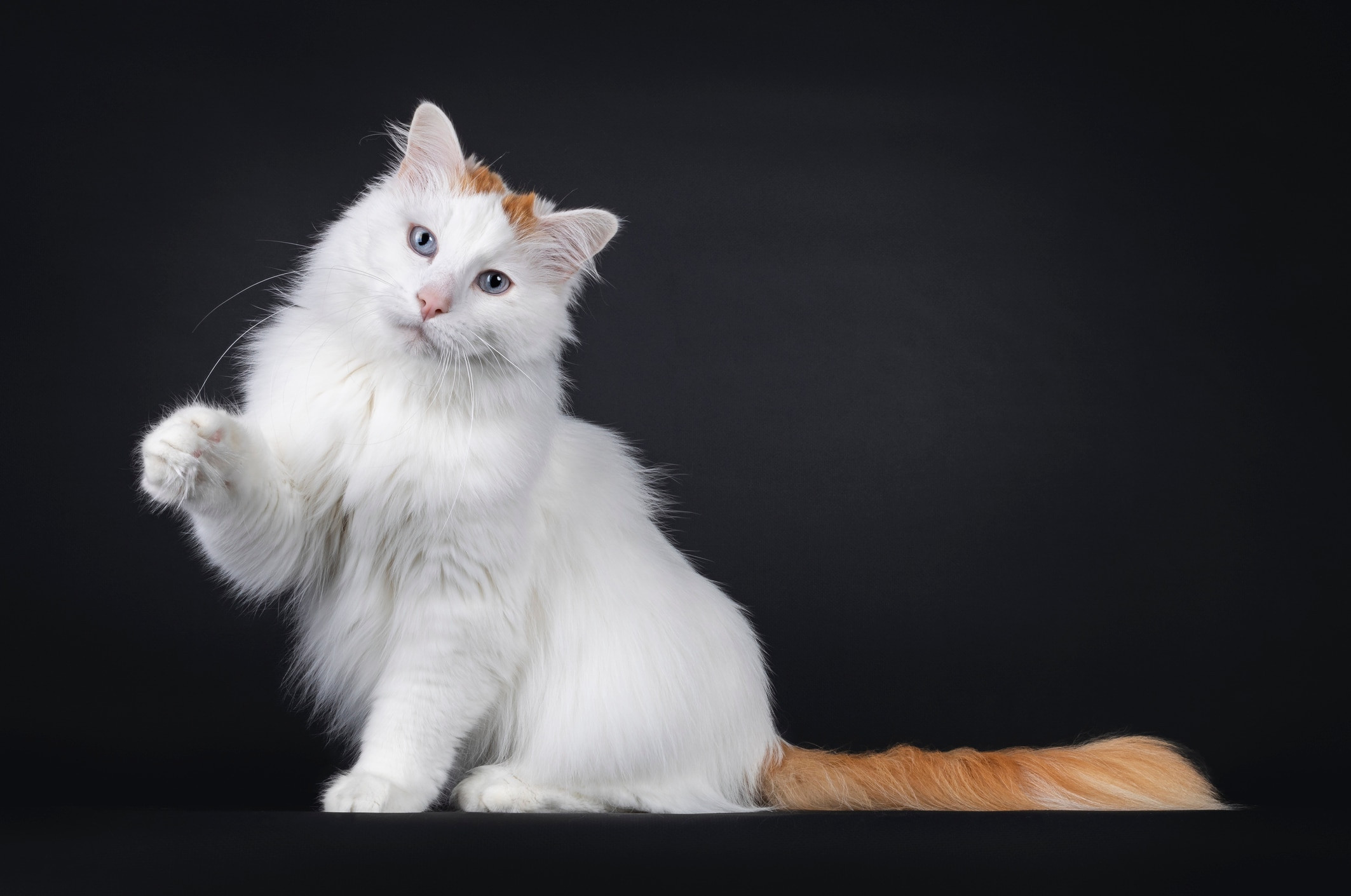 A striking Turkish Van cat, a large and water-loving breed, sitting and playfully pawing in front of a dark background
A striking Turkish Van cat, a large and water-loving breed, sitting and playfully pawing in front of a dark background
Photo by Nynke van Holten/iStock / Getty Images Plus via Getty Images
Weight: 10–20 pounds
The Turkish Van is recognized as one of the largest domestic cat breeds and is particularly notable for their striking appearance and their unusual affinity for water. Unlike most cats who avoid water, Turkish Vans often enjoy playing in pet water fountains or even investigating bathtubs, showcasing their adventurous and curious nature. These active and intelligent cats thrive in environments that offer plenty of enrichment and opportunities for play.
Providing tall cat trees, securely mounted shelves, and engaging scratching posts helps Turkish Vans channel their energy in constructive ways. Regular exercise is also crucial for preventing weight gain and supporting healthy joints throughout their active lives. Their playful and inquisitive spirit makes them a delightful and engaging companion for those prepared to cater to their unique needs.
WRITTEN BY
Shannon Willoby
Freelance Writer

